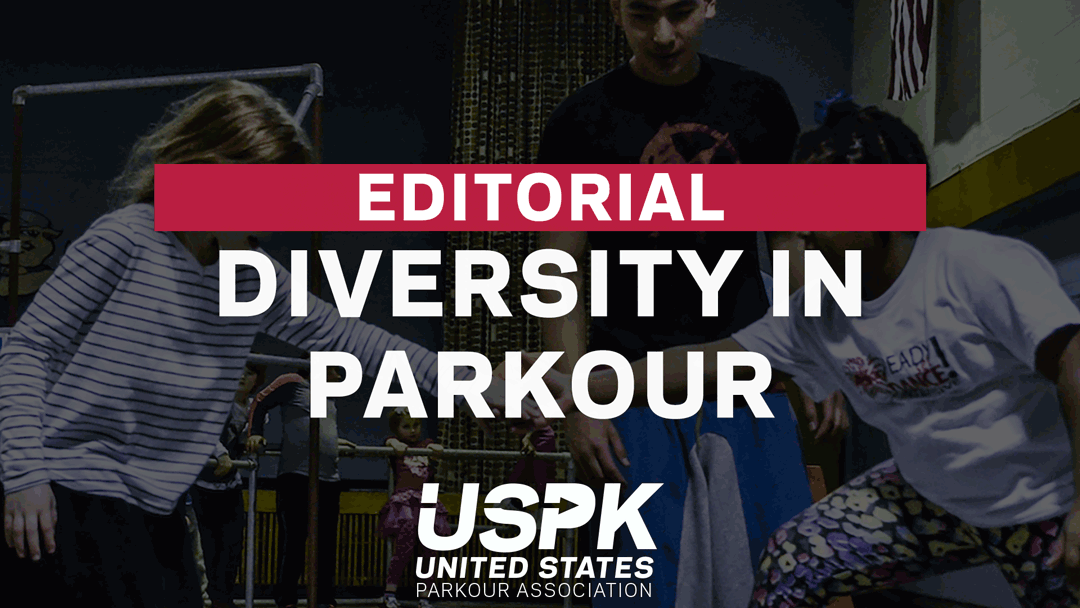
UNITED STATES PARKOUR ASSOCIATION
EDITORIAL – DIVERSITY IN PARKOUR
For the past two weeks I’ve been following the protests and #blacklivesmatter movement and questioning my role and what I can do. As an individual, I realize that most of my responsibility at this point is to listen, to analyze my own interactions and privileges, and to support my fellow citizens in their quest for equality and change in whatever ways I can.
However as a community leader, I have another responsibility to speak out about something that has bothered me for years, but that seems to be continuing, and even accelerating, in the parkour world, a space that is very close to my heart. This is the increasing lack of diversity and the trend towards the “gentrification” of parkour, especially here in the United States. I realize that when contrasted to the day-to-day safety and human rights of POC, parkour training spaces may be low on the priority list, but I hope that this can be a small step toward larger change.
My first exposure to parkour was through the films Yamakasi and Banlieue 13 (District B13). I was struck by how, while fictional, both films touched on the dark history of immigration, politics, and racism in France and how parkour was used to physically and metaphorically overcome some of these obstacles. As I’ve continued with my parkour journey over the years, the relevance of parkour in today’s world to empower, build, and unify has been one of the things that continues to motivate me and guide my efforts. Having spent a number of years researching how parkour can be used as an agent for positive social change, I’ve also come to realize just how important and relevant the roots of parkour are to the long-term growth of the sport / discipline / art form / lifestyle / :insert preferred term:.
Parkour was born in the banlieues outside Paris, the “modern cities” created to house many of the immigrant workers brought in from across the former French colonies and “territorial possessions” while they helped to rebuild a country ravaged by wars, but also to keep them, and eventually their families, at arms’ length from “The City of Light”. These places were often the scenes of racism, stigma and a lack of opportunities that are all too familiar for many POC here in the US. Parkour was a way to overcome some of these barriers, and to create a movement that empowered their fellow community members. When I first visited the ADD Academy, I was able to witness first-hand some of the barriers (and triumphs) that were STILL being faced 15+ years later by a society that didn’t take these talented individuals seriously or value their contributions, largely due to how they looked and where they (or their families) were from. Fortunately parkour / freerunning / ADD has persisted and spread to nearly every corner of the globe, in many places growing much larger and faster than in its original birthplace.
Parkour has a number of unique advantages compared to many sports – it requires no equipment beyond the human body (even shoes are optional to some); the training mentality thrives on overcoming obstacles and creativity- so it works in an almost infinite variety of environments; and it’s a natural unifier- movement and curiosity are universal languages that bridge cultures and backgrounds. It also has an uncanny ability to empower, something that seems to happen across ages, classes, cultures, or backgrounds.
Despite the versatility, the major barrier that persists is access. Access brings knowledge, creates training spaces from nothing, and builds community. At first this access was limited to internet access and the videos that helped to spread parkour to the first generation of practitioners around the globe. Today, there is a new threat to this access, part of which is due to our own success, but also due to a lack of advocacy and action. This is the “gym-ification” and “gentrification” of parkour.
Since coming back to the US I have witnessed, and been part of, an unprecedented period of growth and development in parkour. Many great things have happened during this time and as a community we continue to grow and organize (nod to our community-led United States Parkour Association). However, this growth has included some ugly trends that have been largely ignored, and accessibility to parkour seems to be taking a hit as we see more and more communities behind the walls of gyms.
I realize that there are many reasons for the way that the parkour scene has developed in the United States. Our litigious culture makes property owners and public space managers leery of groups of people training on their property. A gym allows us control over our own space, and enables us to make a space that is dedicated to, and designed specifically for, parkour training. The “box mentality” inherited by our fitness industry values business ownership, profitability, and shiny toys, and I often feel the subtle tug of respectability in this direction, to have a “real” brick & mortar business. Places that lack “good spots” can recreate iconic parkour landmarks from around the world with a degree of density and complexity that are nigh impossible to find in the “real world”- minus the variabilities of weather, lighting, or the general public. All of this has led to an almost exponential pace of growth and development for parkour athletes, and while these are great reasons to encourage and foster the “gym culture”, we also need to take a moment to question what, and who, is being left outside.
One of the trends that has come with this growth is despite our gyms and training facilities becoming more amazing, more complex, and more fun to train in, they are also reaching a smaller and smaller sliver of our surrounding communities. Due to the combination of the cost of real estate in urban centers, the small margins of most grassroots parkour gyms, and the drive toward “profitable markets”, most gyms are located in the suburbs where warehouse space is cheaper, parking is more plentiful, and residents are wealthier. A wealthier clientele often requires/brings a higher price point, which amplifies yet another barrier to entry for many- cost, thus further limiting access.
In many ways our strength as a community comes from diversity- of ideas, of backgrounds, of cultures, of experience, of lifestyles, of training styles, etc. This has been true since the inception of parkour, and is even more important in our current era of divisiveness and inequality in other spheres. We need to do a better job as a community of actively facilitating access for underrepresented groups. It is not enough to passively ensure access, we need to be proactive in our outreach efforts. Looking back at the last few years of my own program development decisions, I’ve come to realize that the programs that offered maximum impact are often hidden behind bureaucratic red tape, low margins, and preconceptions. Once I’ve actually tackled these obstacles, I’ve realized just how valuable these programs actually are, whether through expanding access to wide swathes of the community that had never tried parkour, or by introducing us to much larger networks with a similar mission to make a difference. While the financials for many of these programs are not among our most profitable (if at all), they are often the ones that team members feel most passionately about, and are the ones that I am most proud of.
All that being said, I fully understand that the road toward increasing diversity is not necessarily easy and requires some hard reflection, soul-searching, and tough discussions. Many of these decisions are made at business level, where concrete numbers are often easier to reconcile than intangible community impact. However we need to hold ourselves, our businesses, and our communities accountable at this level, and support them to make the right decisions. Looking ahead I hope to see more diversity at ALL levels of our community- from more diverse representation on staff rosters and at major events, to expanded social media presence that highlights POC and other underrepresented groups, and additional outreach outside the physical walls of our training spaces.
Some suggestions on ways to move forward:
- Listen. I don’t represent the black community and cannot speak for POC. What am I/ are we missing? It is time for those in positions of leadership to amplify marginalized voices and help to effect change.
- Improve accessibility. Building gyms in urban centers isn’t often possible so parkour needs to come out from beyond the gym walls and ALSO be available in schools, community centers, and public spaces. Reach out to and collaborate with your larger community to create safe public spaces to train- where people of ALL backgrounds can feel comfortable.
- Consider the obstacles. Is your gym or community throwing extra obstacles in the way of participation. Can you get there via public transit? Are there ways around paywalls via scholarships, sliding scale pricing or work study programs? How do people find you?
- Represent the community we want. When we portray parkour, we need to make sure that we’re showing who we want to be as a community, not just those who are already here. If parkour is only seen in the media as being done by young white non-disabled men in fancy gyms then of course it’s hard to get other people engaged. Take a long hard look at the way your gym/community is represented in the media.
- Be proactive. As a community we need to be actively recruiting and fostering involvement by underrepresented groups. Specific intro classes, diversity among staff and leadership, outreach initiatives, targeted programming are all steps that we can take as both individuals and organizations.
- Make safe spaces. Many people may not feel comfortable training in the spaces that young white men go with impunity. Is your training space a welcoming space for participants that aren’t young, white, and male?
- Pursue community AND profitability. Business owners intrinsically understand financial profitability as a metric, but we need our “industry” to also use (positive) impact within the community as a measure of success.
Until now I’ve limited my comments on this topic to friends, my local community, and a select group of fellow business leaders. I now realize that I should be listening harder and speaking up sooner and I pledge to do so moving forward. While these thoughts are my own and do not necessarily represent those of USPK or Parkour Generations Americas, as a leader in these organizations I hope that we can do our part to effect this change and make parkour a more diverse, inclusive, and impactful community.
USPK Board Member and Parkour Generations Americas Director,
Blake Evitt
DISCLAIMER: The information provided does not, and is not intended to, constitute legal or business advice; instead, all information, content, and materials available on this site are for general informational purposes only. The views expressed are those of the individual author and all liability with respect to actions taken or not taken based on the contents of this site are hereby expressly disclaimed.

Great post, Blake. Happy to see you pushing the conversation further in this direction!